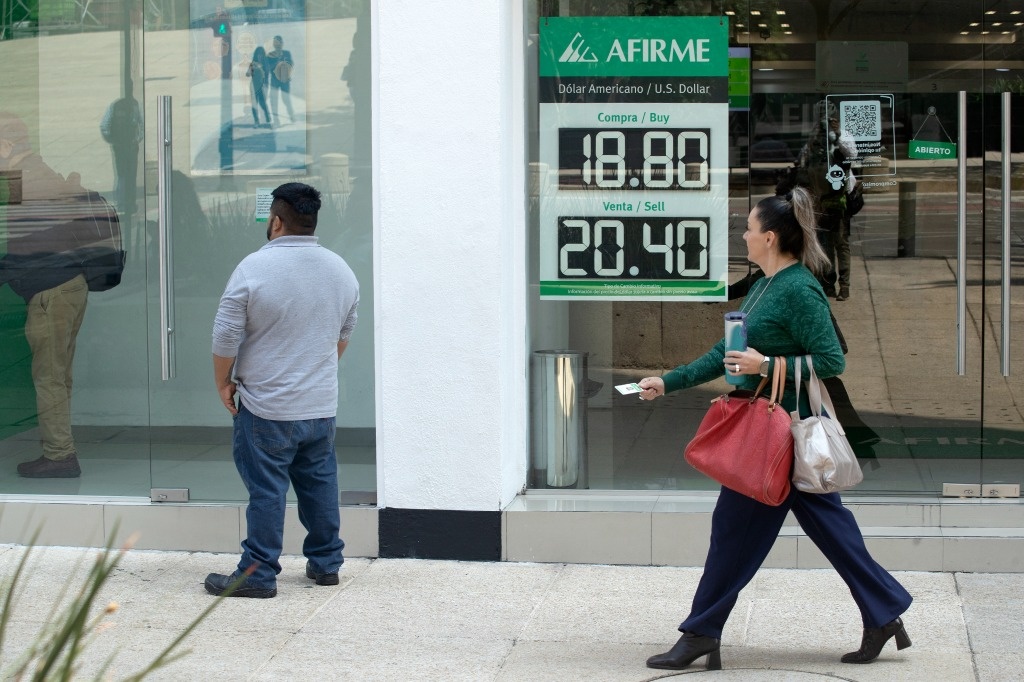Mexico City. Financial markets in Mexico had a mixed day on Thursday. The exchange rate opened the session with a depreciation of over 20 pesos per dollar, while the stock market began the session on the rise. The Mexican currency reduced its morning decline, but the shares of Mexican companies closed with losses.
The Mexican peso closed at practically the same level as the previous close, registering a daily appreciation of 0.06 percent, to end the day in the interbank market at 19.9318 units per spot dollar.
“The exchange rate showed great volatility on Thursday, reaching a maximum of 20.15 pesos per dollar, while the markets digest the recent approval of the judicial reform in the Chamber of Deputies, awaiting the discussion and vote in the Senate,” explained Janneth Quiroz, director of economic analysis at Monex.
According to data from the Bank of Mexico (BdeM), the exchange rate operated between a maximum of 20.0400 units and a minimum of 19.9090 units.
During the session, he noted that members of the U.S. Congress sent a letter to U.S. Trade Representative Katherine Tai to express their concerns about Mexico’s constitutional reforms.
In the letter, they urge Tai to communicate with President Andrés Manuel López Obrador, Claudia Sheinbaum, and Congress to ensure that the reforms do not conflict with the obligations of the USMCA. They also highlight that they are concerned about “any effort by the Mexican government to prohibit or limit certain extraction methods, restrict lithium exploration, restrict electricity operations and permits, restrict imports of genetically modified corn, or abolish independent regulatory bodies.
Amidst all this, the dollar weakened against a basket of six international currencies. According to the DXY index, which measures the performance of the US currency, it depreciated 0.27 percent, to 101.030 units.
Secondary regulation
The Mexican Stock Exchange (BMV), for its part, showed a daily drop of 0.29 percent, closing at 51,661.48 points, mainly affected by the fall of Vitro, 5.35 percent; Kimber, 4.28 percent; Alsea, 1.36 percent; Banco del Bajío, 2.86 percent; Bimbo, 1.21 percent; Cuervo, 3.71 percent; Gap, 1.43 percent; Gruma, 1.13 percent; Walmart, 1.02 percent.
During the session, it was announced that the governing board of the National Banking and Securities Commission (CNBV) approved the secondary regulation of the Securities Market Law, which addresses the definition of the size and how companies will access a simplified issue of shares or debt, with less time, cost and procedures.
The Ministry of Finance estimates that once the secondary regulation is implemented, there will be a potential for stock market financing of around 70 billion pesos annually for small and medium-sized companies in Mexico.
“We want companies to find in the stock market a source of competitive financing that complements the alternatives of other sectors and intermediaries,” said Gabriel Yorio, Undersecretary of Finance, during the last National Week of Financial Education of the current administration.
Now, this secondary regulation will be sent to the National Commission for Regulatory Improvement (Conamer). Thus, market participants, at first, considered this to be good news.
Employment data awaited
Wall Street closed mixed, with the Nasdaq concluding its first session of gains this month and the market closely watching the publication of monthly US employment data on Friday, which will provide clues about the health of the US economy.
The Nasdaq technology index rose 0.25 percent to 17,126.95 points; the S&P 500 index lost 0.30 percent to 5,503.41 points; and the Dow Jones Industrial Average fell 0.54 percent to 40,755.75 points.
Concerns on Wall Street returned after employment data from ADP, the platform that tracks payrolls for most US companies, revealed that 99,000 private sector jobs were created in August, far fewer than expected.
However, weekly jobless claims were slightly lower than expected and investors are now awaiting the US Department of Labor’s report on nonfarm payrolls for August, expected on Friday and whose weak July version sparked fears of a recession.
Brent futures fell 0.01 percent to $72.69 a barrel, while U.S. West Texas Intermediate (WTI) crude fell 0.07 percent to $69.15.
Oil prices held near 14-month lows on Thursday as concerns about demand in the United States and China and a likely rise in supplies from Libya offset a sharp draw in U.S. inventories and an announcement by OPEC+ of a delay in an increase in its output.
#Mexican #peso #closes #dollar
– 2024-09-16 11:01:49


